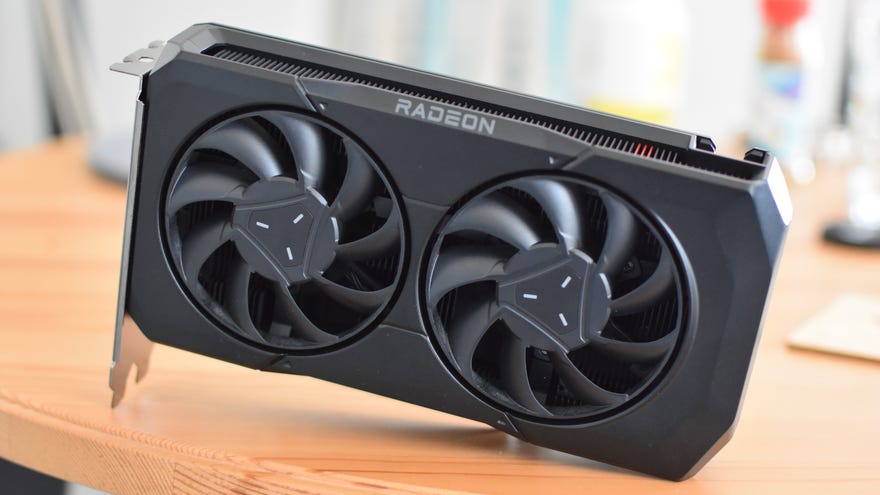AMD Radeon RX 7600 review: a GPU with nothing new
There are worse 1080p graphics cards. Better ones, too
This AMD Radeon RX 7600 review will explain, I’d hope, a fair bit about the red team’s newest 1080p graphics card. It will tell you how fast it runs games, how hot it gets, how it compares to Nvidia’s RTX 4060 and suchlike. What I can’t explain with it, admittedly, is why the RX 7600 exists.
You’d think AMD would be gnashing at Nvidia’s throats right now: the GeForce RTX 40 series has some good cards and a cool trick in DLSS 3, but is blemished by excessive pricing on its higher-end models and merely incremental performance improvements on its more attainable cards. It’s been the least exciting GeForce generation in donkey’s years, and yet AMD’s only attempt to capitalise on the sub-£300 market is... something that barely outruns the last-gen Radeon RX 6650 XT.
There is a competent 1080p GPU here, it must be said, and you can kind of see where the intent was with its RDNA 3 architecture. While the RX 7600 is another 8GB card that packs the same total of 32 Compute Units (CUs) as the RX 6650 XT, RDNA 3 allows for each of these CUs to squeeze in twice as many arithmetic logic units, increasing compute performance. Despite this, the RX 7600 is more efficient too – AMD rates its maximum, full-board power draw at 165W, down from 180W on the RX 6650 XT. I recorded my test unit, an AMD reference card, pulling between 161W and 163W, so it’s an accurate spec.
It's also a few coins cheaper than its main, green-eyed rival, the RTX 4060. The latter starts from about £285, whereas it’s easy to find partner versions of the RX 7600 from around £270. AMD actually lists this very reference design on their own store for £253 / $269, chucking in a free copy of Starfield, though it’s currently out of stock in the UK.
AMD Radeon RX 7600 review: 1440p performance
Still, depending on which games you’ll be playing (and, I suppose, how urgently you want a new Bethesda RPG), it could be worth paying a little extra. At 1440p, the RX 7600 frequently equals but never convincingly surpasses the RTX 4060 – its biggest individual lead in these Ultra-quality tests being a mere 4fps in Watch Dogs Legion. It’s the GeForce card that more often finds a double-digit advantage, especially in Shadow of the Tomb Raider and Hitman 3.
Clearly, neither are a match for the RTX 4060 Ti at this resolution, and the RX 7600 would need upscaling help from FSR or Intel XeSS to more consistently hit 60fps. Help which is often available, and can yield impressive results: F1 22 with FSR 2 on Quality mode averaged 85fps, speeding ahead of the RTX 4060’s 75fps result with Quality-level DLSS.
Unfortunately, there's also the issue of FSR rarely looking quite as sharp as the Nvidia-exclusive DLSS does, so there’s more of a fidelity cost to be paid even at 1440p. And with FSR 3.0 still nowhere to be seen, AMD graphics cards lack an answer to the massive framerate boosts afforded by the RTX 40 series’ DLSS 3 upgrade. That 75fps result on the RTX 4060? That was without DLSS 3’s AI frame generation. Flick it on, and it jumps up to 97fps, easily beating the RX 7600’s upscaled effort.
The absence of a DLSS 3 equivalent also makes it harder for the RX 7600 to hide another disappointment: weak ray tracing performance. Hitman 3 with fully rasterised lighting effects may sail along at 110fps, but the addition of full ray tracing sees it collapse to just 34fps. I could get that up to 54fps with FSR on Quality, but meanwhile, running the same effects at native res on an RTX 4060 produces a perfectly playable 43fps. Add Quality DLSS, and it pastes the RX 7600 with 70fps.

DLSS 3 widens the gap even further. Cyberpunk 2077, on Ultra with Psycho-quality ray tracing, is too much for both these GPUs at native 1440p: 16fps on the RX 7600 and 20fps on the RTX 4060. But while the Radeon card can boost up to 43fps by adding FSR 2.1 on Quality mode, DLSS 3 and frame generation allows the RTX 4060 to run these extreme settings at a visibly smoother 57fps. The only cost is a slight increase in input lag, but I find this barely perceptible in most DLSS 3-compatible games I’ve tried.
If you want a budget 1440p card, then, the RTX 4060’s extra flexibility and performance wins out. But even on native, purely non-RT settings, the RX 7600 is repeatedly buzzed by another GPU: the RX 6650 XT. For all of RDNA 3’s architectural improvements, it’s hard to ignore that the RX 7600 is often just a hair faster than its RDNA 2-powered cousin, which is available for about 20% less cash. Could a switch to 1080p, the resolution that the RX 7600 was actually designed for, help it achieve more generational improvements?
AMD Radeon RX 7600 review: 1080p performance
No, is that answer to that. At Full HD the RX 7600 does manage to turn around its deficit in Hitman 3, but is still mainly drawing with the RTX 4060 and losing when it isn’t.
In fairness, both this and the RTX 4060 look like much better propositions at their intended resolution, even coming close to the pricier RTX 4060 Ti in several games. They never fail to reach well beyond 60fps, including for tough’uns like F1 22 and Watch Dogs Legion. Even so, Nvidia edges it in a head-to-head race, and the RX 7600 still has the RX 6650 XT breathing down its neck. A 5fps difference in Metro Exodus, 8fps difference in Hitman 3 and a dead even(!) Shadow of the Tomb Raider result make it hard to see the RX 7600 as a worthwhile update.
At least the RTX 4060’s DLSS advantage is lessened at 1080p. Using any upscaler at this resolution, even the best in its class, will make your games look noticeably blurrier. Hence why – with some exceptions – the like of DLSS and FSR are mainly only recommended for 1440p and above. This is also why upscaler compatibility is less important when you’re shopping for a 1080p card.
Nevertheless, DLSS 3 can still be useful. Because you don’t need to activate the upscaling component to use the frame generation feature, the RTX 4060 can give itself a boost that the RX 7600 simply can’t recreate, all without skimping on resolution sharpness. AMD’s card is effectively stuck at 75fps on Ultra quality, but on the RTX 4060, I could enable frame generation alone to turn that 72fps average into an even slicker 110fps.

Likewise, in Cyberpunk 2077, the RX 7600 could only run a combination of Ultra quality and Psycho ray tracing by enabling FSR 2.1; with this on its Quality mode, I got 43fps. The RTX 4060 could average 55fps with the same Ultra/Psycho combo and no upscaling at all, just a dash of DLSS 3 frame generation. And if you are willing to take the sharpness hit, the addition of Quality DLSS upscaling will push that all the way to 90fps, more than double the RX 7600’s best.
Cyberpunk 2077 also serves as a reminder of the RX 7600’s general lack of ray tracing suitability. Here’s how the RTX 4060 Ti, RTX 4060, and RX 7600 all perform before and after adding Psycho ray tracing at 1080p; although the Radeon actually beats the RTX 4060 with rasterised lighting, it takes by far the worst blow once RT effects are in the mix.
You could stress that ray tracing remains a fully optional part of modern game visuals, one that may not be foremost on the minds of anyone looking at affordable GPUs. But at this point, it is quite deeply entrenched in PC gaming tech, with over 100 games either currently supporting ray tracing or being confirmed to include it at launch. It does seem untoward that a new, specifically gaming-focused graphics card in 2023 is still so prone to crumbling before these upgraded shadows and reflections. It’s not like the RX 7600 is some £180 entry-level model, either – it’s cheaper than average, but still a mid-ranger that could feasibly be the costliest part of a new PC build.
Also, you know what else struggled with ray tracing? The RX 6650 XT. Making the conscious decision to ignore cutting-edge effects in favour of value is, of course, a valid strategy, but then if that’s what you’re doing than this previous-gen card is at least worth considering alongside the RX 7600. It’s much cheaper yet is only narrowly slower, and again, offers an identical 8GB of VRAM.
The newer GPU’s efficiency savings aren’t all that impressive either, especially when compared to fellow new kid the RTX 4060. Exact temperatures and power usages will vary by specific models, but this AMD-build RX 7600 slurped up more electricity than my MSI-customised RTX 4060 (the latter only consuming 111-113W while gaming, with a seemingly one-off peak of 126W). It ran slightly hotter too: the RTX 4060 moved around the 69-74°c range under heavy load, whereas the RX 7600 was more consistently perched at 76°c.

As long as temperatures aren’t dangerously high, a few degree’s difference is small taters next to visually significant gaps in performance. On these grounds, the RTX 4060’s DLSS 3 feature set makes it the better buy, extra £15 be damned. That could still leave the RX 7600 as a worthwhile 1080p GPU, given DLSS support in games is always growing but not yet ubiquitous. Alas, it also faces competition from within, and the RX 6650 XT promises similar specs and performance at a more appealing price.
The RX 7600 is therefore a graphics card that isn’t ambitious enough with its upgrades to go after Nvidia’s performance crown, a shortcoming which simultaneously allows older, cheaper GPUs to keep pace and relevancy. Simultaneously, it’s not interested in targeting budget builders specifically. One or the other would have been fine, but this? I honestly can’t say who the RX 7600 is for, or indeed, why it needed to exist in the first place.
This review is based on a retail unit provided by AMD.









